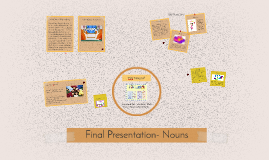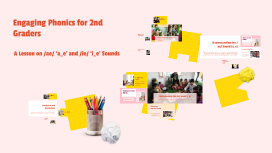Engaging Phonics for 2nd Graders
Transcript: Importance of Phonics in Reading Phonics provides essential skills for recognizing and deciphering words. It helps children associate sounds with letters, enabling them to read independently and develop strong literacy foundations. Engaging Phonics for 2nd Graders Overview of /ae/ and /ie/ Sounds The Role of Phonics in Early Learning /ae/ and /ie/ are prominent phonetic patterns that influence word pronunciation. Recognizing these sounds is vital for developing vocabulary and improving overall reading skills in early education. What is the /ae/ Sound? Phonics is foundational in helping young learners connect sounds to letters, crucial for reading proficiency. Understanding phonetic principles enhances early literacy skills and confidence in reading. The /ae/ sound occurs when the letter 'a' is followed by a silent 'e', producing a long vowel sound, pronounced like 'ay'. This phonics rule is essential for decoding unfamiliar words in reading. Understanding the /ae/ Sound (a_e) Examples of /ae/ Words Objective of the Lesson The /ae/ sound, represented by ‘a_e’, refers to a vowel digraph where the 'a' is followed by a silent 'e', giving the vowel a long sound. This phonetic pattern is crucial for developing reading skills in children. The lesson aims to empower 2nd graders with the ability to recognize and use /ae/ and /ie/ sounds. Mastering these phonics skills will aid in their reading comprehension and fluency. A Lesson on /ae/ ‘a_e’ and /ie/ ‘i_e’ Sounds Common /ae/ words include 'cake', 'take', 'make', and 'snake'. Each of these words illustrates the /ae/ sound, aiding children in their phonetic understanding and vocabulary acquisition. Activities for Practicing /ae/ Sound Effective activities include word sorting, flashcards, and creating sentences with /ae/ words. Engaging exercises help reinforce phonics skills, making learning interactive and fun for second graders. What is the /ie/ Sound? The /ie/ sound is a vowel combination found in words with the structure 'i_e'. This sound is created when the letter 'i' is followed by a silent 'e', altering its pronunciation to /ie/. Understanding this makes reading more accessible for children. Examples of /ie/ Words Recap of Key Concepts Understanding the /ie/ Sound (i_e) The lesson centered on the /ae/ sound as in 'cake' and the /ie/ sound as in 'bike'. Mastery of these phonetic patterns is crucial for reading proficiency, allowing students to build vocabulary and decode new words effectively. Common examples of words containing the /ie/ sound include: 'time', 'like', 'bike', and 'slide'. Introducing these examples helps children recognize and connect the /ie/ sound in different contexts. The /ie/ sound, represented as 'i_e', plays a crucial role in English phonics. It is essential for recognizing and producing words with this sound, contributing to overall reading proficiency. Conclusion and Assessment Practicing the /ie/ Sound Assessment Methods to Evaluate Understanding Summarizing the lesson, we revisit the essential phonics concepts of the /ae/ and /ie/ sounds. Understanding these sounds encourages better reading and spelling skills in 2nd graders, forming a critical foundation for future learning. Fun activities to practice the /ie/ sound include creating word lists, rhyming games, and reading exercises focusing on /ie/ words. Engaging children in these activities solidifies their understanding and pronunciation of /ie/. Evaluate understanding through a mix of informal and formal assessments, including phonics quizzes, reading fluency checks, and interactive games to reinforce learning. This multifaceted approach ensures a comprehensive grasp of the material. Encouragement for Further Practice Encourage students to practice reading books with a focus on /ae/ and /ie/ sounds at home. Suggest parents participate by creating fun phonics games, reinforcing the lesson's objectives outside the classroom environment.

















